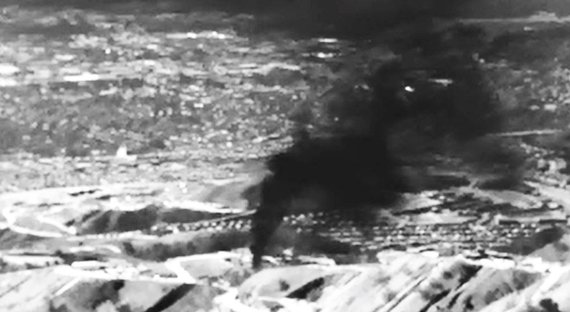Last week, the LA Times Editorial Board observed our presidential candidates' silence on climate change. The Board acknowledged two sad truths: first, climate change is dangerously absent from the national discussion, despite its importance; and second, we shouldn't be surprised that our politicians don't talk about it because it doesn't resonate with voters. The second is a bad excuse for the first. The Board and our candidates are ignoring the devastating influence of climate change on our community.
Had I been in the editorial board meeting, I would have pitched a different piece. I would have suggested an editorial that urged the candidates to visit the places in California where voters are already deeply affected by climate change and the industries that perpetuate it. Presidential campaigns search high and low to find "real people" who can break through the campaign bubble and tell the stories that underpin a candidate's vision; unfortunately, it's increasingly easy to find Californians who confront the effects of climate change every day.
Freeze frame of infrared footage of Southern California Gas Company Aliso Canyon Disaster (Reuters / Environmental Defense Fund)
First the candidates should go to Aliso Canyon. There, the Southern California Gas Company operates a natural gas reservoir that provides gas for 21 million people and thousands of businesses in the region. Last winter, it was the subject of news stories detailing the massive breach in one of its gas wells. The disaster represented the single largest known methane "leak" in the country -- an emission of greenhouse gases more than eighty times as potent as carbon dioxide. In layman's terms, it is equivalent to burning nearly a billion gallons of gasoline. (I could drive my car for about 2 million years with that amount of fuel.)
Instead of doing the typical campaign tour, the candidates could spend time with the folks who live there. They could hear from Porter Ranch residents who still haven't returned home because they fear the residues of heavy metal -- remnants of past oil and gas drilling -- on their kitchen counters, or living room sofas. Or they could hear from students at CSUN, who have walked to class only to find their noses bleeding from the fumes in the natural gas. (They could also call officials from the California Air Resources Board -- one of the the state agencies that administers California's climate policy -- to learn how the Gas Company has publicly dismissed the Board's suggested climate pollution mitigation strategy.)
Signal Hill, overlooking Long Beach, in the 1940s
Oil well on Signal Hill, 2008. (David McNew / Getty Images)
From Aliso Canyon, I'd suggest the candidates follow the gas pipelines south and east into Los Angeles, where they connect to the city's top climate polluters -- facilities that emit carbon dioxide as they burn fossil fuels to generate electricity and refine oil. But even as climate pollution slowly contributes to a global calamity, it immediately coincides with local public health impacts from ozone and particulate emissions. Instead of discussing the far-away effects of a melting glacier, I'd suggest a visit to Wilmington, or Riverside, where the incidence of asthma and respiratory disease is higher because of our continued dependence on fossil fuels. Talk to the families who still live among oil wells. (The Long Beach Oil Field produced nearly a fifth of the nation's oil in the 1920s and Los Angeles continues to produce more than 20 million barrels of oil a year.) After connecting with families, the candidates might visit the South Coast Air Quality Management District -- a public agency charged with implementing the Federal Clean Air Act -- to learn how the California oil lobby helped to oust the agency's Executive Director for doing his job.
A California climate trip would not be complete without a visit to the Central Valley. You can picture the motorcades barreling down the I-5, buzzing past the water propaganda strapped to idle farm trucks that dot the side of the road and urge motorists to support drought assistance measures in Sacramento. I'd encourage the candidates to turn east, off the freeway, and toward places like Tulare, or Corcoran. These are parts of California where folks are literally running out of water. Talk to the farm workers who have trouble finding work because fields have been fallowed or, increasingly, repurposed for novel uses. (A Central Valley observer could not, for example, miss the thousands of acres of dry land transformed into vast solar arrays, which presumably reveal that in drought economics, photovoltaics > photosynthesis.) Don't just consult with the scientists whose research shows us that rising temperatures will lead to less snowpack, earlier melt, and exacerbated drought. But also talk with the families who live downstream, where the coincidence of a prolonged drought, over-pumping of our groundwater, and decades of nitrogen-based fertilizer use have so contaminated their drinking water it is now dangerous to consume.
These are just the greatest hits. There isn't enough space to address all the honorable mentions -- most notably, the downtown LA factory that for years manufactured the batteries we needed to power our gas guzzlers, but left 10,000 nearby homes devastated with lead contamination. If the presidential candidates visited these communities, they could make climate change a more broadly resonant issue. And, together, by empowering the voters whose calls for justice have too long have gone unheard, we could take a step forward toward a more equitable discussion of our climate. It would also go a long way toward bridging the gap the LA Times lamented.
Jake Levine is the energy and technology policy advisor to State Senator Fran Pavley. He previously served as Chief of Staff at Opower, a software company focused on helping people take control of their energy use. He is a former aide to President Obama, where he served in the White House Office of Energy and Climate Change. His opinions are his own.
A version of this article first appeared on Medium.



